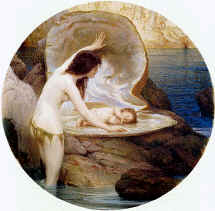Facet # 5 Sexuality
This is a rather long excerpt from my Question and Answer page entitled: "About Jesus & Mary Magdalene-Jesus, sexuality, & the bible" This was written in response to an e-mail that challenged the statement that I made in my column Christ Consciousness that Jesus and Mary Magdalene were mates. I include this part of that page here because it deals with sexuality and the shame around sexuality that is part of Western Civilization. This shame - and the gross imbalance in regard to sexuality that was caused by the flesh is weak and sinful beliefs promulgated by corrupt and hypocritical church leaders - has had a profoundly adverse effect upon Romantic Relationships in Western culture.
From About Jesus & Mary Magdalene page:
"Here is an excerpt from my book about the bible.
"The teachings of all the Master Teachers, of all the world's religions, contain some Truth along with a lot of distortions and lies. Discerning Truth is often like recovering treasure from shipwrecks that have been sitting on the ocean floor for hundreds of years - the grains of Truth, the nuggets of gold, have become encrusted with garbage over the years.
As one example of this, I am going to discuss the Bible for a moment, because it has been such a powerful force in shaping the attitudes of Western Civilization.
The Bible contains Truth, much of it symbolic or in parable form because most of the audience at the time it was written had very little sophistication or imagination. They did not have the tools and the knowledge we have access to now.
So the Bible does contain Truth it also contains a lot of distortion. The Bible was translated many times. It was translated by male Codependents.
continue story below
I am going to share with you a short excerpt from a recently published book. I have not read this book and cannot tell you much about it. I have read a review of this book which appeared in California magazine in November of 1990. What I am sharing here is from that review.
I offer this to you: Not to say that this new translation of the Bible is right and the old one is wrong it is for you to decide which one feels more like Truth to you. I offer this as I offer everything else that I am sharing here as an alternate perspective for you to consider.
This book is called The Book of J. It was written by two men - one of whom is a former head of the Jewish Publication Society, the other is a professor of humanities at Yale University. What they have done in this book is to extract what they believe is one voice from the Old Testament. The Old Testament is a compilation of writings by many different writers. That is why there are two conflicting versions of the Creation in Genesis because it was written by two different people.
They have taken the voice of one of those writers, gone back as far as they could to the original language, and translated it from a different perspective.
Here is a short excerpt from the Old Testament as an example of the difference between their translation and the traditional version. The traditional version is taken from the King James Bible, Genesis 3:16. It says: "And thy desire shall be to thy husband, and he shall rule over thee."
Sounds like the normal patriarchal, sexist tone in which we have always accepted that the Bible was written.
Here is the new translation of the exact same phrase: "To your man's body your belly will rise, for he shall be eager above you."
Now to me, rule over you and eager above you mean two very different things - it actually seems pretty close to being a 180 degree swing in perspective. This new translation sounds as if there is nothing shameful about sex. As if maybe it is not bad to have a normal human sex drive, maybe it is not True that the flesh is weak and the spirit exists somewhere way out there.
The reviewer (Greil Marcus, California magazine, November 1990, Vol. 15, No.11), without ever quite perceiving the shame connection, says that this book "...is an act of violence...to what we think we know." He says that, "...it's a great change, in the way one sees the human condition." He also states that, "The differences...are many and profound...and include .. the replacement of man became a living soul with man becomes a creature of flesh without the distinction between soul and flesh, Christianity, or, as Michael Ventura calls it, Christianism, dissolves.
This retranslation shows that basic misconception and misunderstanding may be at the heart, at the foundation of Western Civilization, or to quote the reviewer, in other words, the argument is that within Jewish, Christian, and Islamic civilization, certainly within Western Civilization, at its heart or at its foundation - is a ruin.
What he could not quite put his finger on as the act of violence against the very core of Jewish, Christian, and Islamic civilization is that what this book seems to do is to take the shame out of being human - of being creatures of flesh. There is no shame in being human. We are not being punished by God. It just feels like it sometimes.
Codependence: The Dance of Wounded Souls
This segues very nicely into:
3. Indecency
You wrote (the person who sent the e-mail): "Would you be kind enough to reply where in the Bible talks about Jesus having humanly desire with Mary Magdalene or even displayed any indecency?"
That your response to my saying "Jesus also had sensual and sexual desires and a mate and lover in Mary Magdalene." - is to equate this to indecency brings up feelings of sadness for me. That one of God's greatest gifts to us - the ability to Touch with Love - has been twisted in our culture into something shameful and indecent is one of the great tragedies of the human condition - in my view.
Here is a quote from my book about my beliefs:
"The gift of touch is an incredibly wonderful gift. One of the reasons we are here is to touch each other physically as well as Spiritually, emotionally, and mentally. Touch is not bad or shameful. Our creator did not give us sensual and sexual sensations that feel so wonderful just to set us up to fail some perverted, sadistic life test. Any concept of god that includes the belief that the flesh and the Spirit cannot be integrated, that we will be punished for honoring our powerful human desires and needs, is - in my belief a sadly twisted, distorted, and false concept that is reversed to the Truth of a Loving God-Force.
We need to strive for balance and integration in our relationships. We need to touch in healthy, appropriate, emotionally honest ways - so that we can honor our human bodies and the gift that is physical touch.
Making Love is a celebration and a way of honoring the Masculine and Feminine Energy of the Universe (and the masculine and feminine energy within no matter what genders are involved), a way of honoring its perfect interaction and harmony. It is a blessed way of honoring the Creative Source.
continue story below
One of the most blessed and beautiful gifts of being in body is the ability to feel on a sensual level. Because we have been doing human backwards, we have been deprived of the pleasure of enjoying our bodies in a guilt-free, shame-free, manner. By striving for integration and balance we can start to enjoy our human experience on a sensual level as well as on the emotional, mental, and Spiritual levels.
As we learn the dance of Recovery, as we tune into the energy of Truth, we can reverse our emotional experience of being human so that most of the time it can feel more like a wonderful summer camp than a dreadful prison."
Codependence: The Dance of Wounded Souls
So, I do not believe that the idea of Jesus having the desires of a human male is indecent. Of course, the desires of human males have been raging out of balance and with no Spiritual foundation or emotional honesty for most of the history of this planet.
Here is a quote from my column Mothers Day:
"Women have been raped, not just physically by men, but also emotionally, mentally, and spiritually by the belief systems of civilization (both Western and Eastern) since the dawn of recorded history.
Those belief systems were the effect of planetary conditions which caused the Spiritual beings in human body to have a perspective of life, and therefore a relationship with life, that was polarized and reversed. This reversed, black and white, perspective of life caused humans to develop beliefs about the nature and purpose of life that were irrational, insane, and just plain stupid.
As just one small but significant example of this stupid, insane belief system, and the effect it had on determining the course of human development including the scapegoating of women, consider the myth of Adam and Eve. Poor Adam, who was just being a man (that is, he just wants to get in Eve's pants) does what Eve wants him to and eats the apple. So Eve gets the blame. Now is that stupid or what? And you wondered where Codependence started.
The stupid, insane perspectives that form the foundation of civilized society on this planet dictated the course of human evolution and caused the human condition as we have inherited it. The human condition was not caused by men, it was caused by planetary conditions! (If you want to know more about those planetary conditions you'll have to read my book.) Men have been wounded by those planetary conditions just as much as women (albeit in quite different ways.)"
Men are supposed to have a strong sexual drive and be strongly attracted to women's bodies - it is part of the genetic programming to insure the survival of the species. It is the nature of the male animal of the human species to want to copulate with the female - that does not mean that I am in any way condoning the gross imbalance and Spiritual vacuum that has been manifested in human civilization around sex.
Part of the reason that there has been such an abusive and patriarchal structure to civilized society is because men have been baffled, confused, and scared of women since the dawn of recorded history. Women have the power to conceive life. There is no greater or more important power in the human species. A woman's ability to conceive and bring forth life gives women an opportunity and capacity to experience Love in a way no man ever can. Men have been jealous and terrified of the power of that Love - and of the power of their own desire to unite with and experience that Love - and reacted to their fear by attempting to subjugate, dominate, and diminish the inherent power of women.
Everything on the physical plane is a reflection of other levels. Ultimately, the emotional power behind the strong sexual and sensual desires of human beings really has little to do with the actual physical act of sex - the True compulsion to unite is about our wounded souls, about our endless, aching need to go home to the God/Goddess Energy. We want to reunite in ONENESS - in LOVE - because that is our True home.
Now, to come down from a metaphysical level to an individual personal level.
The abuse of my sexuality by the shaming religion I grew up in was compounded and magnified by the shame and fear of sexuality I saw in my role models and in society. I grew up in a society that reacted to a fundamental underlying belief that "the flesh is weak" and was incompatible with "decency" - at the same time it bowed to the power of the human sex drive by flaunting sex everywhere. In advertising, in fashion, in the media, books and music, etc. Talk about confusing and frustrating.
In addition to the shame about sexuality - I had shame about being a man because of my fathers role modeling of what a man was, and societal and historical role modeling of how dreadfully "mankind had abused women, children, and men, the weak and poor, anyone who was different, the planet, etc., throughout civilized history.
continue story below
I spent years in recovery working on healing my relationship with my feminine energy and my inner children before it ever occurred to me that I needed to heal my masculine. So now I have spent years also working on healing my masculine. Part of that healing has been about accepting my sexuality and the "male animal" in me. We need to embrace all of the parts of ourselves in order to become whole.
It is only by owning and accepting our "dark" sides that we can start to have a balanced relationship with ourselves. Just as I have to accept that I have a "King Baby" (who wants immediate gratification now) or a "romantic child" (who believes in fairy tales) or a fierce warrior (who wants to vaporize stupid drivers) inside of me so that I can own them and set boundaries for them - I have to accept that there is a "male animal" in me who does want to copulate with most every attractive woman I see. By owning that part of me I can set a boundary for it so that I am not reacting in a way that causes me to be a victim of myself or to victimize someone else.
It is not shameful to be human. It is not shameful to have a sex drive. It is not shameful to have emotional needs. Human beings need to be touched. Way too many of us are starving for touch and affection - and we have acted out sexually in dysfunctional ways to try to get those needs met which often causes us to be bitter and resentful (at the bottom of any resentment is the need to forgive ourselves.) In our codependent extremes we swing between picking the wrong people and isolating ourselves. We believe - because of our experience in reacting out of our disease - that the only choices are between an unhealthy relationship and being alone. It is tragic and sad.
It is tragic and sad that we live in a society where it is so hard for people to connect in a healthy way. It tragic and sad that we live in a society where so many people are touch deprived. But it is not shameful. We are human. We are wounded. We are products of the cultural environments we were raised in. We need to take the shame out of our relationship with our selves, and all the parts of our self, so that we can be healing our wounds enough to be able to make responsible choices. (re - sponse - able, as in ability to respond instead of just react our of old tapes and old wounds.)"
"About Jesus & Mary Magdalene -Jesus, sexuality, & the bible"
So males of the species are genetically programmed to go around wanting to couple indiscriminately with females of the species - while females of the species are genetically programmed to want to bond to one man to produce children and then to protect and provide for her and her children.
Genetic programming that is thousands of years out of date and unnecessary. We are set up by outmoded genetic programming - on top of the cultural dysfunctional programming.
In regard to the inner child healing this male animal usually shows up in a horny teenager - who is aided and abetted in being willing to do anything to get laid by affection and touch starved younger ages, and the romantic - which in emotionally stunted men often takes on a romantic vision of self that has nothing to do with a connection with the Princess. In other words, he wants to see himself as this macho woman killer to fulfill his romantic fantasy of himself but it really doesn't have to do with a human emotional connection or intimacy - because he is incapable of it.
In women this genetic set up can result in a woman keeping a man around for the illusion of having a male protector and supporter. I have worked with many women who not only didn't need to be protected and supported by a man, but they in fact were providing the bulk of the support for the man. In the inner work the maiden within - who is very romantic and believes in fairy tales - is the part of themselves that women can set a boundary with so that they do not unconsciously buy into the set up of the genetic programming.
next: Facet # 6 - Metaphysical
APA Reference
Staff, H.
(2008, November 21). Facet # 5 Sexuality, HealthyPlace. Retrieved
on 2026, January 17 from https://www.healthyplace.com/relationships/joy2meu/facet-5-sexuality
 For the past 25 years, Dr. Richard Grossman has maintained a psychotherapy practice specializing in the treatment of people with relationship problems and general life dissatisfaction. Much of his work has
For the past 25 years, Dr. Richard Grossman has maintained a psychotherapy practice specializing in the treatment of people with relationship problems and general life dissatisfaction. Much of his work has 


